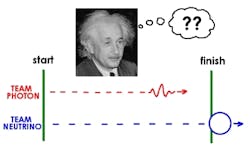OPERA experiment tracks neutrinos at seemingly faster-than-light speeds
Geneva, Switzerland--By measuring the time between the creation of neutrinos and their detection 730 km away, the OPERA experiment has observed neutrinos traveling at a speed that appears to be slightly greater than c, or the speed of light in a vacuum. Independent measurements will be needed before the results can be either refuted or confirmed.
The OPERA (Oscillation Project with Emulsion-tRacking Apparatus) experiment at the Gran Sasso National Laboratory in Italy detects neutrinos that originate at a proton accelerator at CERN (the European Organization for Nuclear Research). The OPERA result is based on the observation of more than 15000 neutrino events measured at Gran Sasso, and appears to indicate that the neutrinos travel at a velocity 20 parts per million above c.
The distance between the origin of the neutrino beam and OPERA was measured with an uncertainty of 20 cm over the 730 km travel path. The neutrinos’ time of flight was determined with an accuracy of less than 10 ns by using instruments including advanced GPS systems and atomic clocks. The time response of all elements of the beam line and of the OPERA detector has also been measured with great precision.
“This result comes as a complete surprise,” said OPERA spokesperson Antonio Ereditato of the University of Bern. “After many months of studies and cross checks, we have not found any instrumental effect that could explain the result of the measurement. While OPERA researchers will continue their studies, we are also looking forward to independent measurements to fully assess the nature of this observation.”
“When an experiment finds an apparently unbelievable result and can find no artifact of the measurement to account for it, it’s normal procedure to invite broader scrutiny, and this is exactly what the OPERA collaboration is doing, it’s good scientific practice,” said CERN Research Director Sergio Bertolucci. “If this measurement is confirmed, it might change our view of physics, but we need to be sure that there are no other, more mundane, explanations. That will require independent measurements.”
For more info, see http://arxiv.org/abs/1109.4897.
